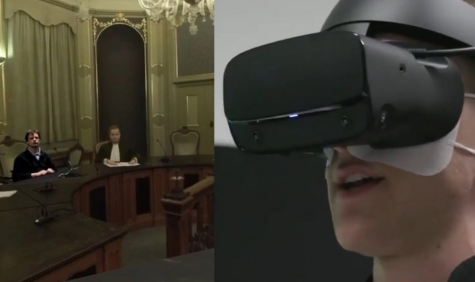Technical support for using VR encourages lecturers to use the technology
VR teaching method PleitVRij taken to next level
The VU, UU and RUG jointly developed a VR teaching method to let law students argue in a very realistic setting, called PleitVRij. The teaching method is a success, but further development and scaling up does not happen by itself. What is involved and what has been achieved in the project 'Learning with Virtual Reality: The Next Level'?
We ask Linde Voorend, content and education support project leader at the university library and the Centre for Teaching and Learning at VU Amsterdam. In that role, she manages the Tech Lab, among other things. She says: "Our Tech Lab has two components: 3D printing and VR. Both technologies take effort and money to manage. That's a task you can't put on lecturers. They know more about didactics than technology. Besides, they already have a sky-high workload. We noticed that lecturers are put off if they have to deal with technology as well. They then choose not to use technology at all, no matter how enthusiastic they are about an application".
Because enthusiasm was high when a few years ago, with money from an earlier round of the Open and Online Education Incentive Scheme, PleitVRij was developed. A VR environment in which students get glasses on and then enter a virtual room in gowns that looks exactly like the court in Groningen, the oldest court in our country. There, they must then make their plea before a 'real' judge - at least: a virtual representation of a real person talking back and asking questions. Voorend: "Previously, law students simply practised pleading in the study group, in front of their fellow students. PleitVRij offers them a realistic experience."
Iterative further development
That first version of PleitVRij was developed by Adriaan Wieringa, Sylvia Moes and Gert-Jan Verheij, among others. This of course involved lecturers, who came with valuable input. But Voorend stresses how difficult it was for them to oversee the possibilities and limitations of the technology beforehand. "That is something you have to discover together gradually in practice. Both lecturers and technicians came up with valuable input after the first version of PleitVRij was realised."
At the time, the project team was already aware that you have to develop a product like PleitVRij agile, in multiple iterations. That is why the three cooperating universities immediately applied for a new round of grants for projects in Open and Online Education. With that money, new glasses could be purchased and PleitVRij could also be further developed in terms of content.
Technical improvements
Voorend says: "In the first version of PleitVRij, we still ran into some technical problems. The glasses often malfunctioned. And the computers and graphics cards needed maintenance. Only the RUG had a technical team providing support. As a result, many hours went into e-mailing back and forth between the RUG, VU and UU. In the follow-up project, a lot of effort was put into the technical support from the VU and UU. Both universities now have a team responsible for technology and for relieving lecturers so that they have absolutely no technical knowledge and can focus purely on didactics. New glasses have also been purchased, which are more stable and reliable."
Didactic further development
Another part of the money was spent on improving the learning environment. For instance, the environment is now not only suitable for learning to plead, but also for practising as a judge. Voorend: "Students from Amsterdam now virtually practice their role as a lawyer with students from Groningen who take on the role of a judge."
The way of giving feedback has also been further developed. "Fellow students assess a lawyer or judge in five different areas via an app. The student who has pleaded or practised the role of judge can download a recording of himself and the feedback himself from the PleitVRij website. Students not only assess the judge or lawyer, but also practise giving feedback to each other," she says.
One of the aspects students are assessed on is non-verbal communication. That aspect in particular can be practised much better with VR than with classroom role-plays, says Voorend. "In such a role-play, you practise with your fellow students, but in PleitVRij you have an unknown judge opposite you who sometimes starts asking questions at unexpected moments. That means you have to improvise. You can only partly fall back on rehearsed behaviour. In the virtual environment, you can assess what it does to someone's attitude if he or she has to use all their brainpower to formulate a good answer at the same time. Does the student still come across as confident at such a moment? It also brings a bit of tension that students have to learn to deal with."
Future developments
Although this sequel to PleitVRij is a significant improvement on the first product, there are certainly still developments to be made, says Voorend. "For example, it would be nice if students could give feedback from home. Right now that is not possible, the students giving feedback have to be physically present at the university."
The role it will play in teaching is also still being tested. At VU University Amsterdam, PleitVRij has been temporarily mandatory and non-committal. A non-compulsory variant is currently being tested where students who participate can earn extra ECTS credits. "We have not yet figured out what works best," says Voorend. "We did see that participation dropped sharply when it was completely optional."
Scaling up
Voorend and her colleagues at UU and RUG are now busy inspiring other universities and universities of applied sciences with PleitVRij as an example. For example, Voorend is speaking at the Media & Learning Conference in Leuven about lessons learned. An event where a delegation from the University of Leuven is sure to attend, but there she no longer needs to introduce PleitVRIJ. "Because they already use the teaching method in a standalone version," she says.
If you want to know more about the possibilities of VR in education, watch the video here or contact techlab.ub@vu.nl. Also check out this project page learning with virtual reality.

